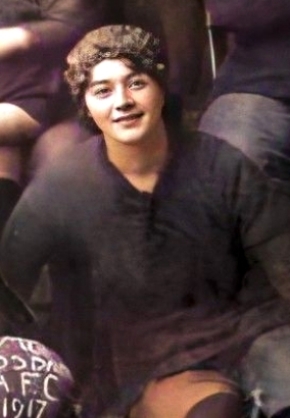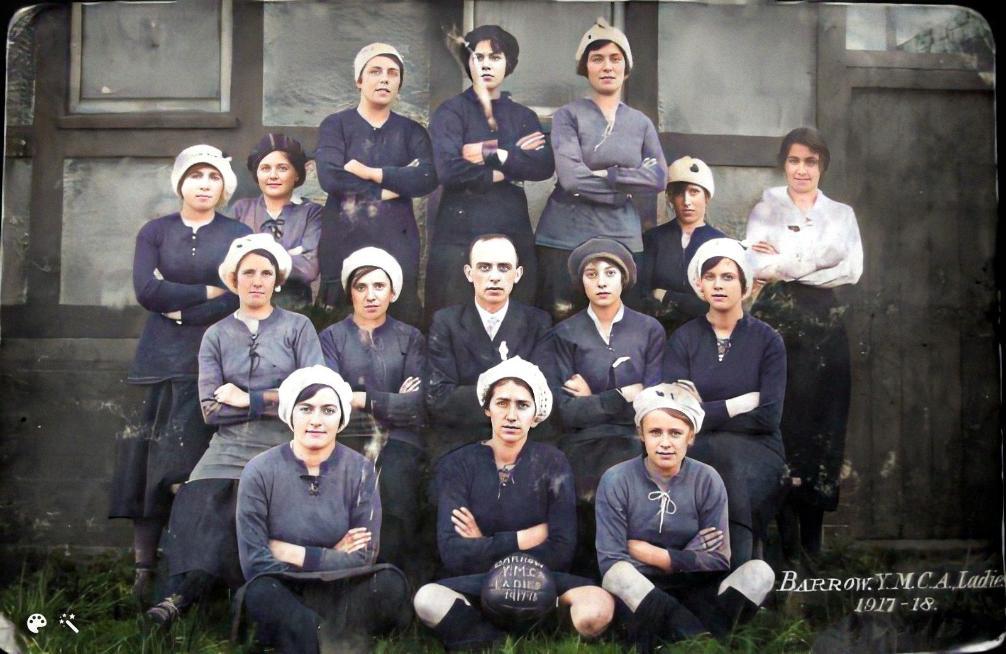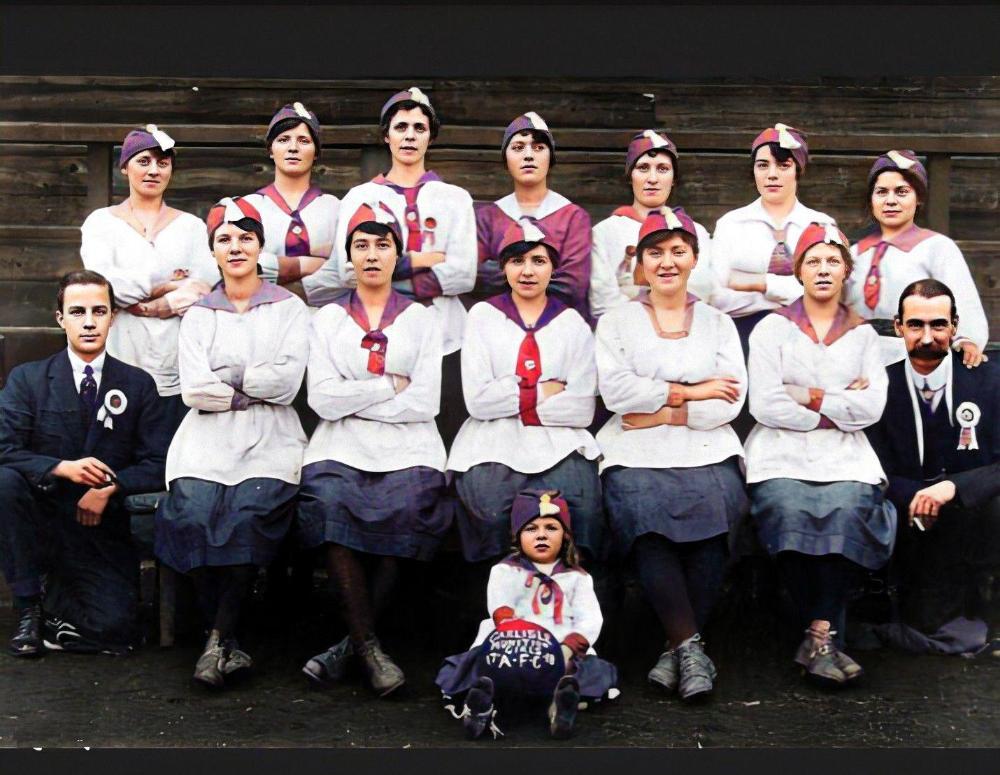Women's Football in the North West
20/10/2021 - 11.03
Stuart Gibbs
By the spring of 1917, the war time women’s football matches were in full swing up the length and breadth of the UK. The north west of the country, which included Lancashire, Westmoreland, Cumberland and the South of Scotland, saw a unique concentration of football activity. The first reported match in the area took place at Workington on 21 April 1917 between the Workington Munition side and Carlisle Munition Girls. The Carlisle side were drawn from the 238 women employed at the East Cumberland Shell Factory on the City’s Strand Road. While Carlisle lost the match 4-1 they managed to keep Workington down to a single goal in the return match the following month at Carlisle United’s Brunton Park. Carlisle had better luck with their next opponents from the giant cordite producing plant at Gretna.
Carlisle Munitions Girls – An early North West side which started playing in early 1917. Image courtesy of Sheila Angus
Gretna Girls and Whitehaven Ladies
The site at HM Gretna stretched 12 miles straddling the Scotland – England border. Gretna’s social manager, Ernest Taylor noted that the works had ‘one or two’ women’s sides and that opinions were split on encouraging participation. This attitude was at odds with other centres in the area with management either encouraging the teams or playing an active role. By contrast the management at Gretna was mostly drawn from the military for their technical background or were late career educationalists, so football for women would have been anthemia. The match between Carlisle and Gretna Girls was played at Brunton Park on 9 June 1917, as a fund raiser for the local V.A.D hospitals with patients from the various hospitals among the crowd. They were treated to an exciting game with Carlisle recording four goals and a Carlisle player Forester putting through her own net for Gretna’s solitary effort.
The next opponents for Workington were another side making their debut, Whitehaven. The Whitehaven side were brought together during the spring of 1917, by Kitty Cowie a former head teacher at the Irish Street School. Kitty played in goal for the first four matches kept a clean sheet. Unlike most of the sides in the district the Whitehaven squad came from the professional classes with many of the players, school teachers. Whitehaven’s star player and captain was Xaveria Wilson, born in the town in 1895 and was the daughter of a local store keeper. Against the Derwent Mills of Cockermouth on 16 June 1917, she scored a hat-trick in the 3-0 win.
Xaveria ‘Vera’ Wilson was a prominent player with Whitehaven Ladies. Image courtesy of Eva Elliott
The Maryport Tournament and the Mossband Swifts
The Derwent Mill was built in the 1830s and during the Great War produced linen for use in covering aircraft. A match held on 30 June 1917, at Maryport Athletic Grounds between Workington and Derwent Mills was the first women’s match to held in the town. Another first was when Derwent Mills took on a team from Ainsworth Mill at Cleator. The Ainsworth Mill, a producer of the Khaki thread used to produce uniforms, shot to prominence in 1915 when the 250 women and 20 boys went out on strike over pay and conditions. The Cleator side continued and on 28 July 1917, recorded a 2-1 win against Seaton at Workington. The women’s match at Maryport not only encouraged the formation of a local side but also a tournament. The competition held at Maryport on 17 August was part of the Alexander Day Sports Fete and besides the new Maryport side, Cockermouth, Whitehaven and three sides from Workington were attracted to the event. Also included was another of the Gretna sides, Mossband Swifts.

Cleator Mills Ladies – Thread workers played several matches during 1917. Image courtesy of Cumbria Archives
The Swifts consisted of A Shift at the Mossband section and one of their star players was Mary Annie Anderson. Born in Scotland at Kirkpatrick Fleming, a village close to Annan; she was 16 when she started playing for the Swifts. The trip to Maryport however was a disappointment with the Swifts losing 1-0 in the first round to the eventual tournament winners Cockermouth. On 15 September, the Mossband Swifts visited Carlisle where they met workers of the local Cumberland works at Brunton Park home of Carlisle United. The Carlisle side went ahead after Miss Graham scored from a first half penalty. In the second period however, Mary Anderson took the ball up field and her cross into the area, found Mary McAdo to equalise. McAdo scored again but this was ruled offside and another chance, just before time, was missed so the match ended at 1-1.

Mary Annie Anderson for the Mossband Swifts early matches at Maryport and Carlisle. Image courtesy of Eva Elliott
Dorothée Pullinger and the Barrow Vickers
Following the success of the Maryport tournament, the Workington Ladies’ Football Competition was organised in the autumn of 1917 and involved teams from Seaton, Cockermouth, Workington, Maryport and Harrington. The final between Seaton and Cockermouth held on 27 October 1917 at Lonsdale Park, was decided by a controversial penalty awarded to Cockermouth. Match referee J. H. Clarridge was charged with winning the cup for Cockermouth and as a result the Seaton players refused to accept their runners up rosettes. In Barrow in Furness, the YMCA Barrow and a side from the Vickers-Maxim plant, were active with Barrow Vickers making their debut at the Holker Street Ground against a team of wounded soldiers on 23 September 1917. Engineer and future car maker, Dorothée Pullinger was posted to Barrow as an administrator for the Vickers works in 1916. She also played a part in organising Barrow Vickers and travelled to Newcastle with the squad when they played Amstrong Whitworth at St James Park. The match was for the ‘Championship of the North’ but Armstrong-Whitworth proved to be the better side winning on the day 2-1. In the return at Holker Street played on 12 January 1918, Vickers put in a better performance to win 2-0. The following month Barrow YMCA pulled out another good result, drawing 1-1 with Dick Kerr.
Workington Ladies – One of three sides that operated in the town with the other prominent team being Workington Combine. Image courtesy of Eva Elliott
Dorothée Pullinger’s connections with the Beardmore Company paved the way for a trip to Glasgow to take on a select side from the Beardmore affiliated works. After selection matches a final line up was drawn from the Mile-end, Parkhead, Mossend and Cardonald factories. Glorious weather attracted a 15,000 crowd to Celtic Park but they were disappointed, as Barrow’s star player Marjorie ‘Madge’ Dickinson scored Barrow’s first two goals in a 4-0 win. Madge was born in Birmingham in 1902 and moved to Barrow when her father took a clerk’s job at the Vickers shipyard. Madge was 16 when she took the field with the Barrow Vickers side. Another good crowd were attracted to Holker Street for the return fixture. The Beardmore Select produced a better performance and were leading 2-1 when a last minute goal tied the game.
The Challenge Shield and Carlisle & Mossband versus Blyth Spartans
The Ladies Challenge Shield, was organised in early spring 1918, with Barrow AFC providing the trophy and medals. It was intended as a four team tournament but Barrow YMCA received a bye in the first round and Barrow Vickers drew 2-2 with Lancaster Ladies in the other match. A dispute over Barrow’s last gasp equaliser led to Lancaster withdrawing altogether. So the Challenge Shield was unique that neither of the finalists had won a match. Played on the 20 April, the final was a least a bit more civil with the Vickers side winning 2-0. Barrow’s Captain, Miss Michaelson called for three cheers for the losers and hoped that the YMCA name would appear on the next year’s trophy. The end of the war seemed to be nowhere in sight.

Barrow YMCA – One of two sides that operated in the town with the other being Barrow-Vickers. Both were finalists in Barrow Shield. Image courtesy of Eva Elliott
The Mossband side seemed to have disbanded by the spring of 1918 but some Mossband players, were included in the Carlisle Munitions Girls side to take on Blyth Spartans in April and May of 1918. Blyth was well on the way to winning the Alfred Wood Munition Girls Cup and the strengthened Carlisle side were no match. Star player Bella Reay bagged a total of five goals as Blyth won handsomely over two matches, home and away. However, attitudes within the Gretna plant towards the women’s teams changed. Women’s matches were organised as part of the fund rising effort for the YMCA. The teams involved came from Broomhills, a section to the south of the Eastriggs township which produced cordite. On 17 August 1918, as part of the workers’ carnival held at Eastriggs, a women’s football match was held between B Shift and C Shift from Broomhills.
Dick Kerr and the Tyneside Select
Whitehaven’s biggest match took place on 21 September 1918, where they entertained Dick Kerr Ladies from Preston. The side was formed in the autumn of 1917 and had only played nine matches with mixed results. This included draws against Barrow YMCA and Lancaster Girls. In the match played at Whitehaven Cricket Ground, Elsie Wilson opened the scoring for the local side only for Florrie Redford to level for Dick Kerr. Whitehaven travelled to Deepdale for the return match on 9 October 1918 and Vera Wilson scored the two goals (one from the penalty spot) to secure a famous win. Whitehaven were not as successful in their last matches as they were in their earlier matches. They lost out 1-0 to Lancaster who had strengthened their side with the inclusion of Walker of Dick Kerr and Madge Dickenson from Vickers.
In a trip to St James Park, Newcastle, they faced a North East select side which included Bella Reay and Winnie McKenna. Played on Boxing Day 1918, the Tyneside Munitionettes won 3-0 with Mary Dorrian and Winnie McKenna among the goal scorers. In the return match played on 18 January 1919, 6,000 spectators crammed into Whitehaven Cricket Ground. Bella Reay scored for the Tyneside select team but Vera Wilson equalised and the match finished as a draw. This seemed to be the last of the war time matches in the North West. In a final sports event, held at Eastriggs on 16 August 1919, football wasn’t on the programme.
The Players in the Post War Years
And what of some of the star players from this area? Vera Wilson of Whitehaven Ladies, married a Whitehaven man, Harold Strathern in the summer of 1919. He died, however, on 16 January 1922. She remarried in the spring of 1936 to Christopher Arnold, a tax officer with the Inland Revenue. The couple lived in Grimsby for many years before retiring to Boston where Vera died in 1972. Mary Annie Anderson settled in Carlisle and in the spring of 1921 married Joseph Irving Lightfoot a former army veteran. Mary Annie Lightfoot died in 1976. There is no evidence that either of these players remained in football after the war but women’s football did continue and one of the Barrow Vickers star’s Madge Dickinson returned for a match against Dick Kerr at Anfield. It was organised by showman, Harry Weldon and Weldon’s XI contained many of the players who turned out for munitions sides across the country. The trophy they competed for is now on display in Manchester at the National Football Museum. Madge Dickinson married a Bertie Tatham in 1923 and lived in Barrow until her death in 1980.
Biography
Stuart Gibbs is a graduate of the Glasgow School of Art. Stuart has participated in exhibitions focusing on women’s football history, these included Moving the Goalposts, First Ladies of Football and a Game for Girls. He has written articles on subjects such as Art, Theatre, and Sports History for Mainly Museums, Discover Magazine, and Playing Pasts. Stuart is also a volunteer researcher with Kent University and was part of the Great War Theatre and Mapping Irish Football research projects. He has contributed to MG Alba’s Honeyballers and Rose Reilly documentaries, and the Futures Theatre Production Offside. Stuart was involved with women’s football as part of the back room staff at Glasgow City FC and Queens Park WFC until 2019.
Follow Stuart Gibbs on:



/prod01/wlvacuk/media/departments/digital-content-and-communications/images-2024/240328-Varsity-Line-Up-Resized.jpg)
/prod01/wlvacuk/media/departments/digital-content-and-communications/images-18-19/220325-Engineers_teach_thumbail.jpg)
/prod01/wlvacuk/media/departments/digital-content-and-communications/images-2024/240423-Additive-Research-Centre-Launched.jpg)
/prod01/wlvacuk/media/departments/digital-content-and-communications/images-2024/240320-Uzbekistan-Resized.jpg)
/prod01/wlvacuk/media/departments/digital-content-and-communications/images-2024/240229-The-Link-Resized.jpg)
/prod01/wlvacuk/media/departments/digital-content-and-communications/images-2024/240416-Abi-Dare-Resized.jpg)

.JPG)
